Scheffler, care for which should be right at home, is notable for its unpretentiousness and can be acquired without fear by beginner growers. Homeland plants - Australia and New Zealand. The name of the flower is associated with the name of the botanist Jacob Christian Scheffler, who in the 18th century was the first to compose his botanical description.
Material Content:
Scheffler: the nuances of growing
The plant can be tree-like, vine or bush, depending on the species. In total, there are about 600 varieties of shefflers, some of which can be grown at home, including the sheffler hed and sheffler bianca.
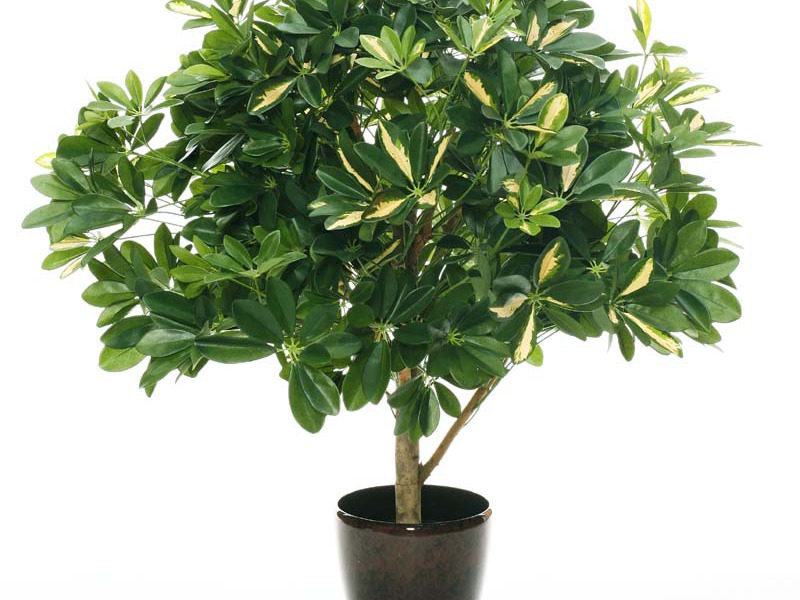
When planting a tree-like form of a plant, it should be borne in mind that it grows up to 2 meters in height and has a fairly sprawling crown. The pot with the plant in question will be large and heavy. The flower grows quickly. You can grow a sheffler only in large tubs that are placed on the floor.
Finger-shaped shiny leaves have the shape of an open palm, and do not lose their decorative appearance. The number of sheet plates in a sheet is up to 16 pieces.
In apartment conditions, the plant never blooms, as it does not grow to a full size, which in nature can reach up to 40 meters.
Home Care
The unpretentiousness of the plant does not mean that the flower does not need to be taken care of. If you create the right conditions for him, for a long time it will delight the owner with its attractive appearance.
Ground and pot requirements
The soil is weakly acidic and nutritious.It’s difficult to buy a suitable substrate, so it’s better to cook it yourself. For this, there are 2 options for soil composition.
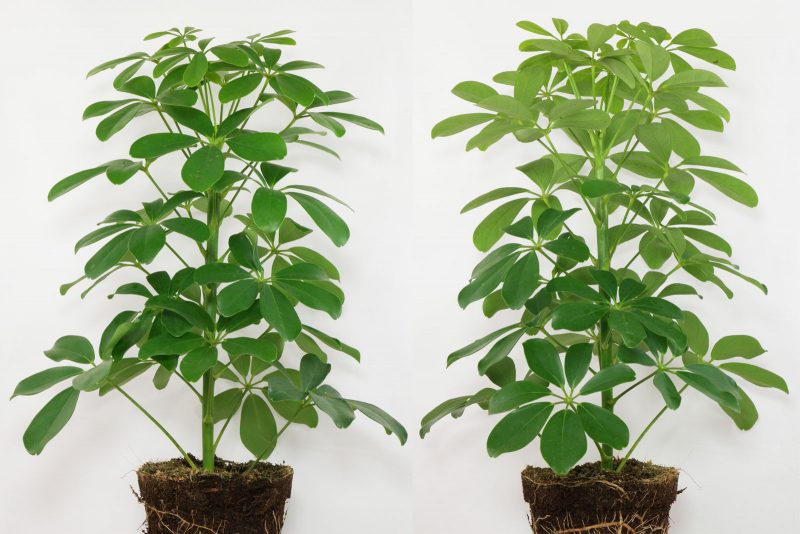
You can prepare the soil from the following ingredients:
- turf land - 4 parts;
- sheet land - 3 parts;
- humus - 2 parts;
- sand - 1 part.
The second version of the soil involves combining in an equal amount of such components:
- peat;
- sand;
- humus;
- turf land;
- sheet earth;
- sand.
In that case, if you can’t prepare the soil on your own, you can buy a substrate for palm trees.
A pot for shefflers requires a very stable and with a large number of drainage holes in the bottom. The capacity should be sufficiently deep and wide.
Temperature, humidity and lighting
Despite the fact that Australia and New Zealand are the birthplace of the flower, where intense heat is the norm, the Scheffler does not tolerate high temperatures. In very hot areas, the plant does not occur in nature. In an apartment, for him it is necessary to provide a temperature of +16 to +22 degrees. If a variegated plant species is grown, then the lower temperature limit is +18 degrees. When the temperature is lower, the condition of the flower worsens, which is poorly reflected in its appearance. If you do not pay attention to the problem in a timely manner, the Scheffler will die.
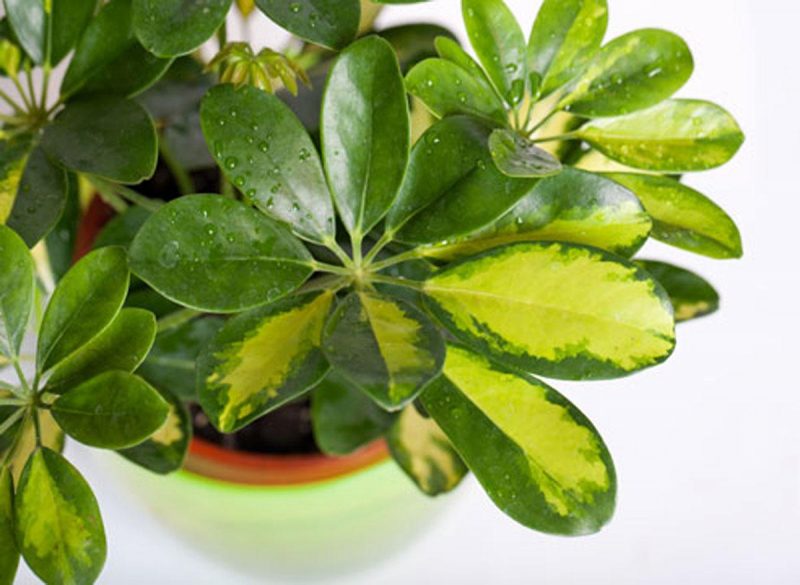
The plant needs high humidity. Therefore, you should regularly spray the flower or wipe its leaves with a sponge moistened in standing water at room temperature. If you do not do this, then the edges of the leaf plates will begin to dry out and the plant will lose its attractiveness.
Intense lighting is required at any time of the year. If the Scheffler suffers from a lack of light, then the leaves will fade and lose their gloss. Direct sunlight is harmful for the flower, as it causes burns on the leaves that look like brown, dry spots of rounded shape. The light that enters the plant must be diffused. It is best to place the pot near the east and west windows. It is permissible to place the sheffler in the northern part of the apartment or office, but only if there is sunlight at least 4 hours a day.
Watering a flower
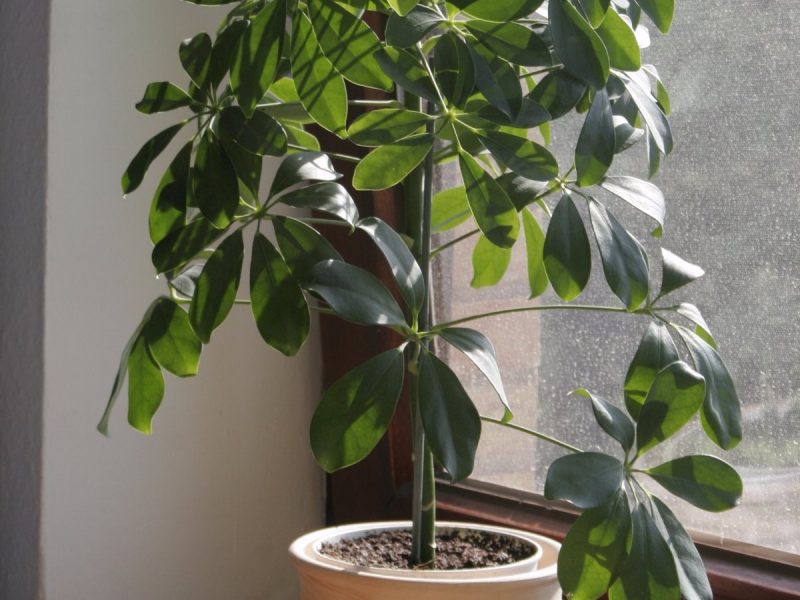
The pallet under the plant should be deep, since in the summer it will require very intensive watering. However, an excessive amount of water leads to the fact that the roots of the indoor flower begin to rot. To avoid this, it is necessary to pour excess water from the pan 12 hours after watering. Watering is carried out once every 5 days, and in extreme heat - once every 2-3 days. For 1 liter of soil, 300 ml of water is required. The individual properties of the plant should be taken into account. The fact that it is time to irrigate is indicated by the drying of the top soil layer.
Fertilizer and fertilizer
Without top dressing, a plant cannot fully develop. Fertilizer application is required only during the period of active growth - from the beginning of March to the end of September. Fertilize should be 1 time per month. Also, during the growing season, it is useful to spray the shefflers with an epin solution once every 3 weeks. In water, the drug should be dissolved in a concentration 2 times lower than indicated in the instructions.
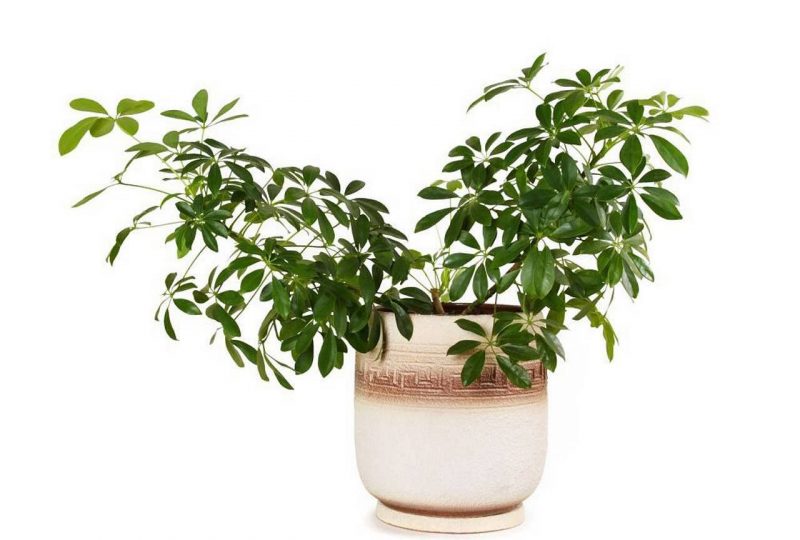
For root dressing, a complex fertilizer for decorative deciduous plants is used, which is bought at a flower shop. It must be applied after watering, while the earth remains wet. How to dissolve the composition is indicated in the instructions for it. The choice of means for feeding is wide.
Pruning

Pruning is carried out in adult plants in order to slow their growth. For this, the tops are cut off on the shoots. In addition to slowing growth, this action allows you to make the flower more magnificent. Cut it in the spring, at the beginning of the growing season. If a sheffler tree grows at home, then pruning allows you to form a beautiful crown of the plant.
Transfer
The root system of the flower grows quickly, and therefore young plants require an annual transplant. It is carried out in the spring or at the very end of winter.A new pot in diameter should be 5-6 cm larger than the previous one.
When the plant is already sitting in the maximum size tank, then once a year, the replacement of the topsoil is needed. This must be done very carefully so as not to damage the roots.
Winter care
In winter, the plant is at rest, and therefore care for it changes somewhat. If the container in which the Scheffler grows already has a maximum size, and therefore there will be no transplant in the spring, then from December fertilizers will be applied. They are bred in 2 times more water than the norm specified in the instructions.
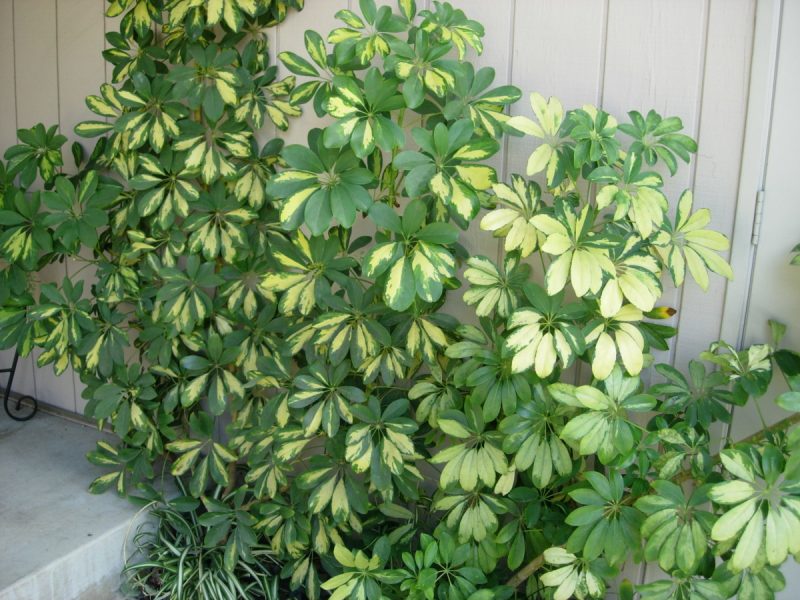
The watering regime also changes in winter. Water the flower should be less often, using 100 ml of water per liter of soil. An indicator that it is necessary to irrigate, as well as in summer, is the drying out of the top soil layer. You can spray with warm water.
Reproduction Schefflera
Self-propagation of a plant on its own is a rather complicated process. However, if desired, an experienced grower may try to do this, for which seeds, cuttings or cuttings are used.
Seeds
Schaeffler almost does not bloom in the apartment, and therefore it is almost impossible to get seeds from him. If it is possible to stimulate the plant to bloom and collect seeds, then they are sown in January or February. Before planting, they must be soaked for 12 hours in a solution of zircon, which is prepared strictly according to the instructions for the drug. Soil for seeds is required, as well as for an adult plant. After the seeds are sown, the soil is moistened and the container is covered with glass to create greenhouse conditions.
It is more convenient to use separate containers so as not to dive later, which is stressful for plants.
Cuttings
Cuttings can only be cut from completely healthy plants. For rooting, a slightly lignified shoot is selected. The cut is cut with a sharp knife, which is previously wiped with an antiseptic.
Then it is placed for 7 hours in a heteroauxin stimulator, after which it is planted in a container with a substrate suitable for the plant. In order for the humidity to be sufficient for root formation, it is necessary to cover the handle with a plastic bag or a glass cap. Airing is carried out 1 time per day for 3 minutes.
Layering
This method involves obtaining air layers. In spring, when the flower enters into active vegetation, a small incision is made on the trunk and covered with sphagnum moss. The moss used is pre-impregnated with a solution of universal fertilizer for decorative and deciduous plants, which is prepared at the rate of: 1 g of the drug per 1 liter of water.

On top of the moss-covered area should be wrapped in polyethylene. It is impossible for the sphagnum to dry out on the trunk. After a few months, roots appear. After giving them 2 months to develop, cuttings are cut slightly below the root formation and planted in a separate pot. Further care for the plant is the same as for an adult.
The main problems when growing
Despite all the unpretentiousness of the plant, it is necessary to provide him with the correct conditions. If this is not done, then there will be problems with the state of the flower.

The most common troubles are:
- yellowing of leaves is a sign that the flower is deficient in nutrients in the soil. To eliminate it, emergency top dressing should be carried out with a complex agent once a week for 1 month;
- dropping leaves - to restore the flower to a normal state, it is necessary to provide the plant with optimal temperature and normalize watering;
- blackening and twisting of leaves - the problem appears if the plant is overfilled, or poor, non-defended water is used to irrigate it. It is best prevented by waterlogging of the soil in a plant pot with high-quality drainage.
If there are no mistakes when growing shefflers, then it does not lose its attractiveness for a long time.
Pests and diseases
The main disease of the plant is dropsy, which appears with excessive watering. The disease appears as pimples on the inside of the leaves. Treatment comes down to normalizing watering.
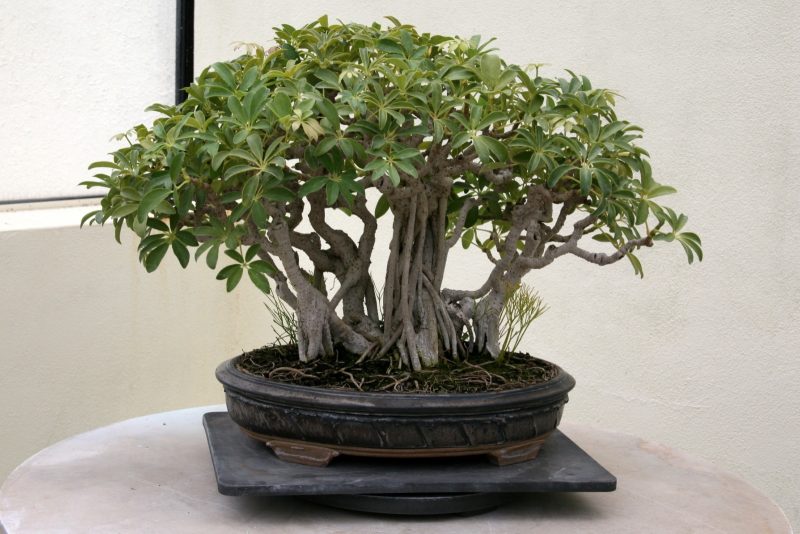
Of the pests for shefflers, aphids, spider mites and scale insects are dangerous. A solution of laundry soap will help get rid of them.
If there is a desire to have a beautiful deciduous plant at home, then a sheffler's indoor flower is the best choice.












